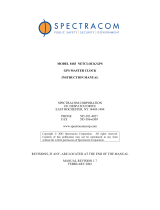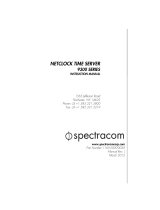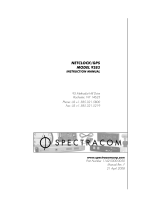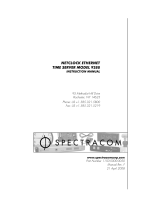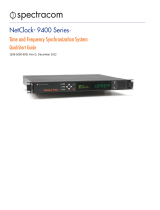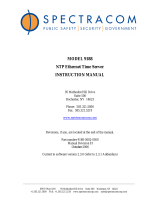Page is loading ...


© 2020 Orolia. All rights reserved.
The information in this document has been carefully reviewed and is believed to be accurate and
up-to-date. Orolia assumes no responsibility for any errors or omissions that may be contained in
this document, and makes no commitment to keep current the information in this manual, or to
notify any person or organization of updates. This User Reference Guide is subject to change
without notice. For the most current version of this documentation, please see our web site at
orolia.com.
Orolia reserves the right to make changes to the product described in this document at any time
and without notice. Any software that may be provided with the product described in this doc-
ument is furnished under a license agreement or nondisclosure agreement. The software may be
used or copied only in accordance with the terms of those agreements.
End-user customers of Orolia products may, without the need for a written license from Orolia,
reproduce and modify any Orolia product documentation accompanying such products, for dis-
tribution within their organization in order to use the products.
Orolia authorized partners, systems integrators, government contractors, and other similarly-situ-
ated third-party installers may, without the need for a written license from Orolia, reproduce Oro-
lia product documentation (including media type changes) and create derivative works thereof in
the form of compilations, for distribution to their end-users.
Except as described above, no part of this publication may be reproduced, stored in a retrieval
system, or transmitted in any form or any means electronic or mechanical, including photocopying
and recording for any purpose without the written permission of Orolia.
Other products and companies referred to herein are trademarks or registered trademarks of their
respective companies or mark holders.
Orolia USA, Inc.
• 45 Becker Road, Suite A, West Henrietta, NY 14586 USA
• 3, Avenue du Canada, 91974 Les Ulis, France
The industry-leading Spectracom products you depend on are now brought to you by Orolia, the
global leader in Resilient Positioning, Navigation and Timing Solutions.
Do you have questions or comments regarding this User Reference Guide?
è E-mail: techpubs@orolia.com
Warranty Information
See the website: http://www.orolia.com/support/spectracom/warranty- information for a
copy of Spectracom's Limited Warranty policy.
NetClock User Reference Guide I

Blank page.
II NetClock User Reference Guide

CONTENTS
NetClock User Reference Guide • TABLE OF CONTENTS
III
CHAPTER 1
Product Description
1
1.1 Getting Started
2
1.2 Introduction
2
1.3 NetClock 9483 Overview
2
1.3.1 NENA Standards Compliance & Support
3
1.3.2 Security Enhancements
4
1.4 NetClock 9489 Overview
4
1.5 Inputs & Outputs
4
1.5.1 NetClock 9483: Standard Outputs
4
1.5.2 NetClock 9483: Optional Outputs
5
1.5.3 NetClock 9489 Standard Inputs and Outputs
5
1.6 NetClock 9400 Series Front Panels
5
1.6.1 NetClock 9483 Front Panel
5
1.6.2 NetClock 9489 Front Panel
6
1.6.3 Front Panel Keypad, and Display
6
1.6.3.1 Using the Keypad
6
1.6.3.2 Navigating the Front Panel Display
7
1.6.4 Status LEDs
8
1.7 NetClock 9400 Series Rear Panels
10
1.7.1 NetClock 9483 Rear Panel
10
1.7.2 NetClock 9489 Rear Panel
11
1.8 NetClock 9483—Available Option Modules
13
1.8.1 T1 (1.544 MHz) and E1 (2.048 MHz) Module
13
1.8.2 Multi-Port Gigabit Ethernet Module
13
1.8.3 PTP Grandmaster Module
14
1.9 The NetClock Web UI
14
1.9.1 The Web UI HOME Screen
15
1.9.2 The INTERFACES Menu
16
1.9.3 The Configuration MANAGEMENT Menu
16
1.9.4 The TOOLS Menu
17

1.10 Specifications
18
1.10.1 Input Power
18
1.10.1.1 Fuses
19
1.10.2 GNSS Receiver
19
1.10.3 RS-232 Serial Port (Front Panel)
20
1.10.4 RS-232 Serial Port (Rear Panel; NetClock 9483 Only)
20
1.10.5 RS-485 Serial Port
20
1.10.6 10/100 Ethernet Port
20
1.10.7 IRIG Output (NetClock 9483 Only)
20
1.10.8 Protocols Supported
20
1.10.9 1PPS Output
21
1.10.10 10 MHz Output (NetClock 9483 Only)
21
1.10.10.1 10 MHz Output — Oscillator Phase Noise (dBc/Hz)
22
1.10.11 Mechanical and Environmental Specifications
23
1.11 Regulatory Compliance
24
CHAPTER 2
SETUP
27
2.1 Overview
28
2.1.1 Main Installation Steps
28
2.2 Unpacking and Inventory
29
2.3 Required Tools and Parts
29
2.3.1 Required GNSS Antenna Components
30
2.4 SAFETY
30
2.5 Mounting the Unit
34
2.5.1 Rack Mounting
34
2.6 Connecting Supply Power
35
2.6.1 Power Source Selection
36
2.6.2 Using AC Input Power
36
2.6.3 Using DC Input Power (NetClock 9483 Only)
37
2.7 Connecting the GNSS Input
39
2.8 Connecting Network Cables
40
2.9 Connecting Inputs and Outputs
40
2.10 Powering Up the Unit
41
IV
NetClock User Reference Guide • TABLE OF CONTENTS

2.11 Setting up an IP Address
42
2.11.1 Dynamic vs. Static IP Address
43
2.11.2 Assigning a Static IP Address
43
2.11.2.1 Setting Up an IP Address via the Front Panel
44
2.11.2.2 Setting Up a Static IP Address via a DHCP Network
46
2.11.2.3 Setting Up an IP Address via the Serial Port
47
2.11.2.4 Setting up a Static IP Address via Ethernet Cable
48
2.11.3 Setting Up a Temporary IP Address Remotely
49
2.11.4 Subnet Mask Values
50
2.12 Accessing the WebUI
50
2.13 Connecting Reference Inputs and Network Interface
52
2.14 Configure Network Settings
54
2.14.1 General Network Settings
56
2.14.2 Network Ports
56
2.14.3 Network Services
60
2.14.4 Static Routes
61
2.14.5 Access Rules
63
2.14.6 HTTPS
64
2.14.6.1 Accessing the HTTPS Setup Window
64
2.14.6.2 About HTTPS
66
2.14.6.3 Supported Certificate Formats
66
2.14.6.4 Creating an HTTPS Certificate Request
67
2.14.6.5 Adding HTTPS Subject Alternative Names
70
2.14.6.6 Requesting an HTTPS Certificate
71
2.14.6.7 Uploading an X.509 PEM Certificate Text
73
2.14.6.8 Uploading an HTTPS Certificate File
74
2.14.7 SSH
75
2.14.8 SNMP
82
2.14.8.1 SNMP V1/V2c
86
2.14.8.2 SNMP V3
88
2.14.8.3 SNMP Traps
90
2.14.9 System Time Message
92
2.14.9.1 System Time Message Format
93
2.15 Configure NTP
94
2.15.1 Checklist NTP Configuration
94
2.15.2 The NTP Setup Screen
94
NetClock User Reference Guide • TABLE OF CONTENTS
V

2.15.3 Dis-/Enabling NTP
97
2.15.4 Viewing NTP Clients
98
2.15.5 Restoring the Default NTP Configuration
98
2.15.6 NTP Output Timescale
99
2.15.7 NTP Reference Configuration
100
2.15.7.1 The NTP Stratum Model
101
2.15.7.2 Configuring "NTP Stratum 1" Operation
101
2.15.7.3 Configuring "NTP Stratum Synchronization"
102
2.15.8 NTP Servers and Peers
103
2.15.8.1 The NTP Servers and NTP Peers Panels
104
2.15.8.2 NTP Servers: Adding, Configuring, Removing
106
2.15.8.3 NTP Peers: Adding, Configuring, Removing
108
2.15.9 NTP Authentication
110
2.15.9.1 NTP Autokey
110
2.15.9.2 NTP: Symmetric Keys (MD5)
116
2.15.10 NTP Access Restrictions
119
2.15.11 Enabling/Disabling NTP Broadcasting
120
2.15.12 NTP over Anycast
121
2.15.12.1 Configuring NTP over Anycast (General Settings)
122
2.15.12.2 Configuring NTP over Anycast (OSPF IPv4)
123
2.15.12.3 Configuring NTP over Anycast (OSPF IPv6)
124
2.15.12.4 Configuring NTP over Anycast (BGP)
125
2.15.12.5 Configuring Anycast via NTP Expert Mode
126
2.15.12.6 Testing NTP over Anycast
129
2.15.13 NTP Orphan Mode
129
2.15.14 Host Disciplining
130
2.15.14.1 Enabling Host Disciplining
131
2.15.15 NTP Expert Mode
131
2.15.16 Spectracom Technical Support for NTP
134
2.16 Configuring Input References
135
2.17 Configuring Outputs
135
2.17.1 The Outputs Screen
136
2.17.2 The 1PPS and 10MHz Outputs
137
2.17.2.1 Configuring a 1PPS Output
138
2.17.2.2 Configuring the 10 MHz Output (NetClock 9483 Only)
139
2.17.3 Configuring Optional Outputs
139
2.17.4 Network Ports
139
VI
NetClock User Reference Guide • TABLE OF CONTENTS

2.17.5 Signature Control
139
CHAPTER 3
Managing Time
143
3.1 The Time Management Screen
144
3.2 System Time
145
3.2.1 System Time
146
3.2.1.1 Configuring the System Time
146
3.2.1.2 Timescales
147
3.2.1.3 Manually Setting the Time
148
3.2.1.4 Using Battery Backed Time on Startup
150
3.2.2 Timescale Offset(s)
152
3.2.2.1 Configuring a Timescale Offset
152
3.2.3 Leap Seconds
153
3.2.3.1 Reasons for a Leap Second Correction
153
3.2.3.2 Leap Second Alert Notification
154
3.2.3.3 Leap Second Correction Sequence
154
3.2.3.4 Configuring a Leap Second
155
3.2.4 Local Clock(s), DST
156
3.2.4.1 Adding a Local Clock
156
3.2.4.2 DST Examples
158
3.2.4.3 DST and UTC, GMT
159
3.3 Managing References
159
3.3.1 Input Reference Priorities
159
3.3.1.1 Configuring Input Reference Priorities
161
3.3.1.2 The "Local System" Reference
164
3.3.1.3 The "User/User" Reference
165
3.3.1.4 Reference Priorities: EXAMPLES
167
3.3.2 Reference Qualification and Validation
170
3.3.2.1 Reference Monitoring: Phase
170
3.3.2.2 Interference Detection and Mitigation (IDM Suite)
171
3.3.3 BroadShield Alarm
175
3.3.4 BroadShield Web UIMonitoring
176
3.3.5 The GNSS Reference
180
3.3.5.1 Reviewing the GNSS Reference Status
181
3.3.5.2 Determining Your GNSS Receiver Model
185
3.3.5.3 Selecting a GNSS Receiver Mode
187
NetClock User Reference Guide • TABLE OF CONTENTS
VII

3.3.5.4 Setting GNSS Receiver Dynamics
190
3.3.5.5 Performing a GNSS Receiver Survey
192
3.3.5.6 GNSS Receiver Offset
193
3.3.5.7 Resetting the GNSS Receiver
194
3.3.5.8 Deleting the GNSS Receiver Position
195
3.3.5.9 Manually Setting the GNSS Position
196
3.3.5.10 GNSS Constellations
199
3.3.5.11 A-GPS
203
3.4 Holdover Mode
208
3.5 Managing the Oscillator
212
3.5.1 Oscillator Types
213
3.5.2 Configuring the Oscillator
214
3.5.2.1 Time Figure of Merit (TFOM)
215
3.5.3 Monitoring the Oscillator
216
3.5.4 Oscillator Logs
219
CHAPTER 4
System Administration
221
4.1 Powering Up/Shutting Down
222
4.1.1 Powering Up the Unit
222
4.1.2 Shutting Down the Unit
223
4.1.3 Issuing the HALT Command Before Removing Power
223
4.1.4 Rebooting the System
224
4.2 Notifications
225
4.2.1 Configuring Notifications
226
4.2.2 Notification Event Types
228
4.2.2.1 Timing Tab: Events
228
4.2.2.2 GPS Tab: Events
228
4.2.2.3 System Tab: Events
229
4.2.3 Configuring GPS Notification Alarm Thresholds
229
4.2.4 Setting Up SNMP Notifications
230
4.2.5 Setting Up Email Notifications
231
4.3 Managing Users and Security
233
4.3.1 Managing User Accounts
233
4.3.1.1 Types of Accounts
233
4.3.1.2 About "user" Account Permissions
233
4.3.1.3 Rules for Usernames
235
VIII
NetClock User Reference Guide • TABLE OF CONTENTS

4.3.1.4 Adding/Deleting/Changing User Accounts
235
4.3.2 Managing Passwords
237
4.3.2.1 Configuring Password Policies
238
4.3.2.2 The Administrator Password
238
4.3.2.3 Lost Password
239
4.3.3 LDAP Authentication
242
4.3.4 RADIUS Authentication
248
4.3.4.1 Enabling/Disabling RADIUS
248
4.3.4.2 Adding/Removing a RADIUS Server
249
4.3.5 TACACS+ Authentication
251
4.3.5.1 Enabling/Disabling TACACS+
251
4.3.5.2 Adding/Removing a TACACS+ Server
252
4.3.6 HTTPS Security Levels
253
4.3.7 Unlocking the Keypad via Keypad
254
4.3.8 If a Secure Unit Becomes Inaccessible
254
4.4 Miscellanous Typical Configuration Tasks
255
4.4.1 REST API Configuration
255
4.4.2 Web UI Timeout
255
4.4.3 Configuring the Front Panel
256
4.4.4 Displaying Local Time
259
4.4.5 Creating a Login Banner
260
4.4.6 Show Clock
261
4.4.7 Configuring an External Display Clock
262
4.4.8 Product Registration
264
4.4.9 Synchronizing Network PCs
265
4.4.10 Selecting the UI Language
265
4.5 Quality Management
265
4.5.1 System Monitoring
265
4.5.1.1 Status Monitoring via Front Panel
265
4.5.1.2 Status Monitoring via the Web UI
266
4.5.1.3 Status Monitoring of Input References
269
4.5.1.4 Reference Monitoring: Phase
271
4.5.1.5 Ethernet Monitoring
272
4.5.1.6 Outputs Status Monitoring
273
4.5.1.7 Monitoring the Oscillator
276
4.5.1.8 Monitoring the Status of Option Modules
279
4.5.1.9 NTP Status Monitoring
281
NetClock User Reference Guide • TABLE OF CONTENTS
IX

4.5.1.10 Temperature Management
286
4.5.2 Logs
292
4.5.2.1 Types of Logs
293
4.5.2.2 Local and Remote Logs
297
4.5.2.3 The Logs Screen
297
4.5.2.4 Displaying Individual Logs
298
4.5.2.5 Saving and Downloading Logs
300
4.5.2.6 Configuring Logs
301
4.5.2.7 Setting up a Remote Log Server
304
4.5.2.8 Restoring Log Configurations
306
4.5.2.9 Clearing All Logs
306
4.5.2.10 Clearing Selected Logs
307
4.6 Updates and Licenses
307
4.6.1 Software Updates
307
4.6.2 Applying a License File
309
4.7 Resetting the Unit to Factory Configuration
310
4.7.1 Resetting All Configurations to their Factory Defaults
311
4.7.2 Backing-up and Restoring Configuration Files
311
4.7.2.1 Accessing the System Configuration Screen
312
4.7.2.2 Saving the System Configuration Files
314
4.7.2.3 Uploading Configuration Files
314
4.7.2.4 Restoring the System Configuration
315
4.7.2.5 Restoring the Factory Defaults
316
4.7.3 Cleaning the Configuration Files and Halting the System
316
4.7.4 Default and Recommended Configurations
317
4.7.5 Sanitizing the Unit
318
4.7.5.1 Physically Removing the CF Card
318
4.7.5.2 Cleaning/Restoring
319
4.7.5.3 Removing Other Files From the CF Card
319
4.7.5.4 Further Reading
320
APPENDIX
Appendix
321
5.1 Troubleshooting
322
5.1.1 Troubleshooting Using the Status LEDs
322
5.1.2 Minor and Major Alarms
323
5.1.3 Troubleshooting: System Configuration
324
X
NetClock User Reference Guide • TABLE OF CONTENTS

5.1.3.1 System Troubleshooting: Browser Support
325
5.1.4 Troubleshooting – Unable to Open Web UI
325
5.1.5 Troubleshooting via Web UI Status Page
326
5.1.6 Troubleshooting GNSS Reception
328
5.1.7 Troubleshooting – Keypad Is Locked
329
5.1.8 Troubleshooting – 1PPS, 10 MHz Outputs
329
5.1.9 Troubleshooting – Blank Information Display
330
5.1.10 Troubleshooting the Front Panel Serial Port
331
5.1.11 Troubleshooting the Front Panel Cooling Fan
332
5.1.12 Troubleshooting the Internal Battery
332
5.1.13 Troubleshooting – Network PCs Cannot Sync
333
5.1.14 Troubleshooting Software Update
334
5.2 Option Modules
335
5.2.1 NetClock 9483 Option Modules
335
5.2.2 NetClock 9489 In-/Outputs
336
5.2.2.1 1PPS Output
336
5.2.2.2 ASCII Time Code RS-485 Outputs and Input
336
5.2.3 Accessing Option Module Settings via the WebUI
340
5.2.3.1 Web UI Navigation: Option Modules
341
5.2.3.2 Viewing Input/Output Configuration Settings
342
5.2.3.3 Configuring Option Module Inputs/Outputs
343
5.2.3.4 Viewing an Input/Output Signal State
345
5.2.3.5 Verifying the Validity of an Input Signal
346
5.2.4 NENA-Compliant Module
347
5.2.4.1 NENA-Compliant Module: Specifications
348
5.2.4.2 IRIG Output Specifications
348
5.2.4.3 ASCII RS-232 Specifications
349
5.2.4.4 ASCII RS-485 and Alarms/Relays Specifications
350
5.2.4.5 Configuring the IRIG Time Code Output
352
5.2.4.6 Configuring an ASCII Time Code Output (RS-232 or RS-485)
354
5.2.4.7 Configuring the Relay/Alarm Output
357
5.2.5 Gigabit Ethernet Module [Option 16]
358
5.2.5.1 Gigabit Ethernet Module: Specifications
358
5.2.5.2 Network Setup
359
5.2.5.3 Routing Tables
359
5.2.6 T1/E1 Out Module [Option 13]
360
5.2.6.1 Module Option 13 E1/T1 (120 Ω): Specifications
361
NetClock User Reference Guide • TABLE OF CONTENTS
XI

5.2.6.2 Model 1204-53 E1/T1 (75 Ω): Specifications
362
5.2.6.3 E1/T1 Output: Edit Window
362
5.2.6.4 E1/T1 Output: Status Window
363
5.2.7 PTP Grandmaster [1204-32]
364
5.2.7.1 PTP Grandmaster [-32]: Specifications
364
5.2.7.2 PTP Grandmaster [-32]: Edit Window
365
5.2.7.3 PTP Grandmaster [-32]: Status Window
371
5.2.7.4 Configuration — General Steps
375
5.2.7.5 Configuration — PTP-Specific Steps
375
5.3 Command-Line Interface
380
5.3.1 Setting up a Terminal Emulator
380
5.3.2 CLICommands
381
5.4 Time Code Data Formats
386
5.4.1 NMEA GGA Message
386
5.4.2 NMEA RMC Message
387
5.4.3 NMEA ZDA Message
388
5.4.4 Spectracom Format 0
388
5.4.5 Spectracom Format 1
390
5.4.6 Spectracom Format 1S
391
5.4.7 Spectracom Format 2
392
5.4.8 Spectracom Format 3
395
5.4.9 Spectracom Format 4
396
5.4.10 Spectracom Format 7
398
5.4.11 Spectracom Format 8
399
5.4.12 Spectracom Format 9
400
5.4.12.1 Format 9S
401
5.4.13 Spectracom Epsilon Formats
402
5.4.13.1 Spectracom Epsilon TOD1
402
5.4.13.2 Spectracom Epsilon TOD3
402
5.4.14 BBC Message Formats
403
5.4.14.1 Format BBC-01
403
5.4.14.2 Format BBC-02
404
5.4.14.3 Format BBC-03 PSTN
405
5.4.14.4 Format BBC-04
407
5.4.14.5 Format BBC-05 (NMEA RMC Message)
408
5.4.15 GSSIP Message Format
408
5.4.16 EndRun Formats
409
XII
NetClock User Reference Guide • TABLE OF CONTENTS

5.4.16.1 EndRun Time Format
409
5.4.16.2 EndRunX (Extended) Time Format
410
5.5 IRIG Standards and Specifications
411
5.5.1 About the IRIG Output Resolution
411
5.5.2 IRIG Carrier Frequencies
412
5.5.3 IRIG B Output
416
5.5.3.1 FAA IRIG B Code Description
419
5.5.4 IRIG E Output
422
5.5.5 IRIG Output Accuracy Specifications
426
5.6 Technical Support
427
5.6.1 Regional Contact
428
5.7 Return Shipments
428
5.8 License Notices
428
5.8.1 NTPv4.2.8p12
428
5.8.2 OpenSSH
432
5.8.3 OpenSSL
435
5.9 List of Tables
439
5.10 List of Images
440
5.11 Document Revision History
441
INDEX
NetClock User Reference Guide • TABLE OF CONTENTS
XIII

BLANK PAGE.
XIV
NetClock User Reference Guide • TABLE OF CONTENTS

CHAPTER 1 • NetClock User Reference Guide
1
CHAPTER 1
Product Description
The Chapter presents an overview of the NetClock 9400 Series Time
Server, its capabilities, main technical features and specifications.
The following topics are included in this Chapter:
1.1 Getting Started 2
1.2 Introduction 2
1.3 NetClock 9483 Overview 2
1.4 NetClock 9489 Overview 4
1.5 Inputs & Outputs 4
1.6 NetClock 9400 Series Front Panels 5
1.7 NetClock 9400 Series Rear Panels 10
1.8 NetClock 9483—Available Option Modules 13
1.9 The NetClock Web UI 14
1.10 Specifications 18
1.11 Regulatory Compliance 24

1.1 Getting Started
Welcome to the NetClock User Reference Guide.
Where to start:
First-time users: "Introduction" below.
Users with some knowledge of Time and Frequency Servers: "Overview" on page28.
If your unit is up and running and you want to change a setting: "Managing Time" on
page143, or "System Administration" on page221.
1.2 Introduction
The NetClock
®
9400 Series combines Spectracom’s precision Time Server/Master Clock tech-
nology and secure network-centric approach with a compact modular hardware design to
bring you a powerful time & frequency reference and synchronization system at the lowest cost
of ownership.
The NetClock 9400 product series is ideally suited for a variety of communications applic-
ations such as Emergency Communications Centers that require extremely accurate timing and
frequency synchronization for their mission-critical systems, networks, and devices. The NetC-
lock 9400 product series consists of two variants: The model 9483 is fully compliant with the
National Emergency Number Association (NENA) master clock standard, and the model 9489.
1.3 NetClock 9483 Overview
The NetClock 9483 has been designed specifically for these environments, and when using
GPS as its timing reference, the UTC (Coordinated Universal Time) time standard is employed,
thus allowing the NetClock 9483 to provide legally traceable time and frequency syn-
chronization services for various related environments and equipment, such as the following:
2
CHAPTER 1 • NetClock User Reference Guide Rev. 20
1.1 Getting Started

9-1-1 and PSAP communication center telephony
Computer network synchronization
VOIP/voice and video recording
CAD
ANI/ALI controllers
Radio consoles and communications equipment
Display clocks
Security & building access systems, fire alarm systems
The NetClock 9483 also includes backwards-compatibility support with all previous generation
NetClock products; thus providing a bridge from legacy devices and equipment to network-
based systems.
The NetClock 9483 series is a truly flexible Time Server/Master Clock, which in addition to
providing highly accurate network time synchronization, also supports a variety of timecodes
(including all NEMA formats) and signals to synchronize specific devices. The built-in network
port can be supplemented to include 3 additional Gigabit Ethernet (10/100/1000Base-T) ports
for synchronizing isolated networks, or for restricting administration to a specific management
network. Precise 10-MHz and 1-Pulse-per-second (1PPS) signals are standard features, and
additional optional features include support for T1/E1 signals are available for synchronizing
telecom systems and equipment, and Precision Timing Protocol (PTP) I/O support.
The unit is housed in a 19” rack unit chassis and offers an integrated power supply. DC power
is available as back-up to AC power, or as the primary input power source.
Note: All features described are not available on all NetClock 9400 Series vari-
ants.
Initial setup of the NetClock 9483 can be done via its front panel serial port interface, and fur-
ther management and configuration can be performed via NetClock’s Web-based user inter-
face.
1.3.1 NENA Standards Compliance & Support
The NetClock Model 9483 is designed to meet or exceed the following NENA standards and
criteria:
NENA PSAP Master Clock Standard #04-002
NENA Security for Next-Generation 9-1-1 Standard (NG-SEC) #75-001
Note: Information regarding the configuration of the NetClock’s NENA module
can be found under "NENA-Compliant Module " on page347.
1.3 NetClock 9483 Overview
CHAPTER 1 • NetClock User Reference Guide Rev. 20
3

1.3.2 Security Enhancements
In addition to fully supporting the NENA Security Standard #75-001, the NetClock 9400 series
are security-hardened network appliances designed to meet rigorous network security stand-
ards and best practices. They ensure accurate timing through multiple references, tamper-proof
management, and include extensive logging capabilities for auditing purposes. All features,
interfaces, ports, and protocols can be enabled or disabled based on your network policies.
1.4 NetClock 9489 Overview
Spectracom’s NetClock Model 9489 delivers the same high precision timing benefits of the
NetClock 9483, and is ideally suited for delivering highly precise NTP timing for syn-
chronizing systems, devices, and other communications equipment and devices.
In addition to providing a secure, high precision NTP platform, NetClock 9489 also provides
one (1) 1PPS output, two (2) RS-485 outputs, and (1) RS-484 input.
There are a number of commonly shared features between both the NetClock 9483 and 9489
models. However, the NetClock Model 9489 is designed to function primarily as an NTP
server, and therefore is somewhat less complex than the NetClock Model 9483. Also, NetClock
9489 is not fully compliant to NENA master clock technical requirements. As such, a majority of
this document applies to the NetClock Model 9483, except where otherwise noted.
1.5 Inputs & Outputs
Spectracom NetClock provides multiple outputs for use in networked systems and devices. GPS-
equipped NetClocks can track up to thirty-two GPS satellites simultaneously and synchronize to
the satellite’s atomic clocks. This enables NetClock-equipped computer networks to synchronize
all elements of network hardware and software over LANs or WANs – anywhere on the planet.
1.5.1 NetClock 9483: Standard Outputs
Standard outputs are:
Type Connector
(1) Ethernet 10/100Base-T RJ-45 (auto-sensing)
(1) RS-232 Serial Connector DB9 female
(1) RS-485 Once-per-Second 3.81 mm Terminal Block
(1) IRIG B/E, IEEE 1344/C37.118-2005 (AM/TTL) output BNC
(1) 1 Pulse Per Second (1PPS) output BNC
(1) 10 MHz Frequency output BNC
(2) Relay / Alarm Outputs 3.81 mm Terminal Block
4
CHAPTER 1 • NetClock User Reference Guide Rev. 20
1.4 NetClock 9489 Overview
/

